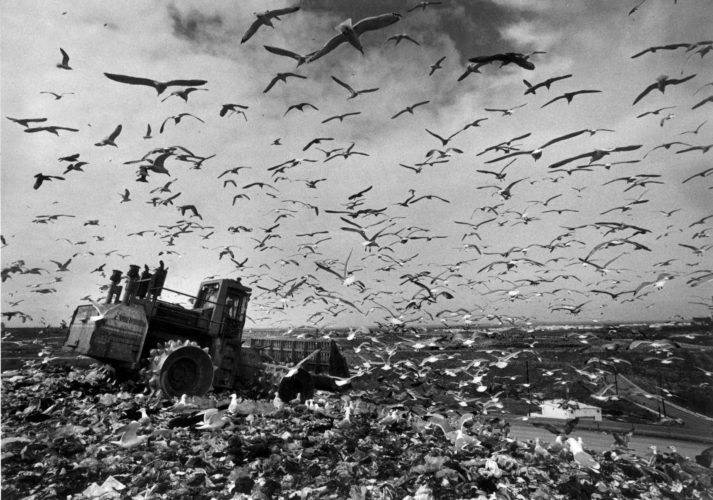Fresh Kills Landfill Closed in 2001, but Large Landfills Still Loom

Birds fly over the piles of garbage at the Fresh Kills Landfill in 1993. (Image courtesy of the Staten Island Advance and Staten Island Institute Archives.)
Before closing almost two decades ago, Fresh Kills Landfill was known as the largest landfill in the world. During peak operations in the 1980s, Fresh Kills received as much as 29,000 tons of trash per day. By 1991 it was the last remaining landfill in New York City, accepting household trash from all five boroughs. A total of 150 million tons of solid waste came to the landfill during its fifty-three years of operation.
As the landfill transforms into public parkland, the project is an example of how to plan for a greener future. But trash is still produced and then shipped to landfills around the world. While most garbage ends up at established landfills, there are waste accumulations in four of the world’s oceans that continue to grow. Here are three of the world’s current largest receptacles of waste.
Apex Regional Landfill – Las Vegas, NV
Located just a few miles outside Las Vegas Nevada, Apex Regional Landfill is the largest operating landfill in the United States. At 2,200 acres, it has the same footprint as Freshkills Park. Each day Apex accepts 10,500 tons of municipal solid waste for Las Vegas and the surrounding area. It has been open for over 25 years, and it has a projected lifespan of 250 years, putting its expected closure date near 2250. Apex Landfill also has a methane capture system in place and produces 11 megawatts of electricity a year, enough to power about 11,000 homes.
Laogang Landfill – Shanghai City, China
Laogang Landfill accepts half of Shanghai City’s total municipal waste, a total of 10,000 tons daily. It is the largest landfill in China, and one of the largest in Asia. Like Freshkills, the Laogang Landfill has a methane capture system and generates 103,000 megawatt-hours, enough to power 100,000 homes. Closed sections of the landfill are currently in the process of reclamation. Scientists are experimenting with soil and plants seeking to establish the most attractive and the hardiest plants that could resist drought and wind and absorb pollutants. The area will eventually become a park, with hills and wetlands much like Freshkills Park.
The Great Pacific Garbage Patch – Pacific Ocean
The Great Pacific Garbage Patch is the largest of five offshore accumulations of plastic in the world. Garbage washes into municipal storm water systems, blows into the ocean, or gets dumped directly into the water, and it accumulates in these large gyres as ocean currents collect millions of individual pieces of trash. A recent sampling of the Garbage Patch revealed between 1.1 and 3.6 trillion pieces of plastic, estimated to weigh 80,000 tons. This accumulation spans 1.6 million square miles–twice the size of Texas. This massive amount of plastic has many negative effects on marine life in the Pacific. Animals often ingest the materials. Many plastics have persistent bio-accumulative toxins, which means that they are passed along from prey to predator, becoming more concentrated along the way. Fishing nets account for almost half of the mass of the Pacific Garbage Patch, and many sea creatures die from entanglement.
Fresh Kills Landfill is on its way to becoming a sustainable park, but the landfill’s mounds remind us of the impact of our garbage. Fortunately, more and more people realize the importance of reducing waste, and there are initiatives focused on combating waste management issues worldwide. In 2018, the UN Environment Program created its Global Plastics Platform to support countries attempting to curb plastic use and increase recycling. These include recent initiatives by India, Chile, Peru, and Botswana to ban plastic bags, and the establishment of recycling plants across Nigeria. In the same year, 23 global cities, including New York City, signed the Advance Towards Zero Waste Declaration, pledging to cut the amount of waste generated by each citizen by 15%, reduce the amount of waste sent to landfills and incineration by 50%, and increase the diversion rate to 70% by 2030.
According to the NYC Department of Sanitation, New Yorkers are producing less waste at home than ever before, and 68% of what we do throw away belongs in a curbside recycling or organics bin. The City is working to send zero waste the out-of-state landfills by 2030. There are many steps involved in reaching this goal, including expanded recycling, launching curbside organics pick-up, promoting education in NYC schools, and providing information on e-waste and clothing reuse.




